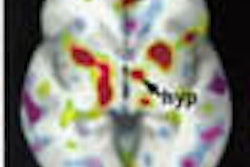SAN FRANCISCO - A PET imaging study presented at this week's Chest 2000 conference found that radiation therapy for lung cancer may induce changes in untreated lung tissues. Follow-up studies will be needed to determine what PET is actually finding, but the modality could play a role in monitoring post-radiation changes in untreated lung tissue.
As PET is used more frequently for lung cancer staging and follow-up, PET studies have noted possible radiation toxicity in shielded lung regions that were not irradiated, according to Dr. Elliot Cohen, a radiologist from Rush Presbyterian St. Luke's Medical Center in Chicago. Increased lymphocytosis and bronchiolitis obliterans with organizing pneumonia (BOOP) in contralateral lung regions have all been noted, mostly in breast cancer patients but also in lung cancer patients, he said.
"With that in mind, the purpose of this study was to determine if sequential PET scans identified areas of increased metabolic activity after localized radiation therapy for primary lung cancer," Cohen said.
The team retrospectively reviewed the records of 16 patients with biopsy-proven lung cancer who had undergone FDG-PET imaging both before and after radiation therapy. Only patients who had undergone localized radiation treatment with shielding of uninvolved areas were included, from records gathered over a period of 11 months.
No time limits were imposed for PET scanning before or after treatment; there was a mean of 98 days between PET scans. Radiation doses ranged from 4,000 to 4,400 cg, and all of the patients were treated concurrently with chemotherapy. None of the patients were treated with corticosteroids or other agents known to cause lung inflammation.
A nuclear medicine physician, who had no knowledge of the sequence of the scans or the course of treatment, reviewed two scans for each patient.
"Seventy-five percent of the patients showed uptake in four patterns, 25% of the patients showed no changes after radiation, and all patients showed tumor regression," Cohen said.
The two most common patterns were contralateral peripheral pleural uptake in five patients (31.2%), and ipsilateral peripheral pleural uptake in 5 patients (31.2%). There was also bilateral peripheral pleural uptake in 1 patient (6.2%), and diffuse background uptake in 1 patient. Three patients showed no increased uptake (18.8%), and only one patient developed clinically significant pneumonitis, Cohen said.
"What we found is that increased metabolic activity in PET scans may be shielded in non-irradiated areas after localized radiation therapy. We don't know if this shows increased lung toxicity or what this uptake represents," Cohen said.
Cohen acknowledged the need to control imaging times and other factors such as the effects of chemotherapy and radiation volume.
"We're planning on doing a prospective study where we look at patients at different times before and after radiation therapy, and also be able to do bronchoalveolar lavage and pleural biopsies on these patients to determine what's actually going on in the changes we saw in the pleura," Cohen said. "The clinical implication is that radiation therapy may affect the non-irradiated lung, which has been shown previously."
Audience members had their own ideas. One said the study needed a control group of patients who had undergone radiation treatment without chemotherapy.
Another suggested that reactive macrophages might be responsible for the positive readings. "I think what we're seeing is the actual white cell uptake by FDG. We found that to do PET scans fewer than six weeks [after radiotherapy] we often pick up these false positives," he said.
Nevertheless, Cohen said there appeared to be a definite pattern that merited further investigation. "What was most interesting about the study was that possibly fibrosis or injury may start at the pleura, and this has been demonstrated previously in animal models of radiation-induced lung injury," he said.
By Eric BarnesAuntMinnie.com staff writer
October 27, 2000
Let AuntMinnie.com know what you think about this story.
Copyright © 2000 AuntMinnie.com




















